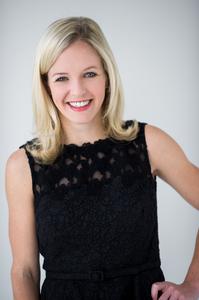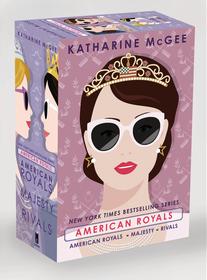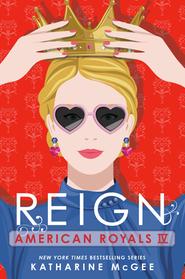
|
|
| (credit: Chris Bailey Photography) | |
Katharine McGee is the author of the American Royals series and the Thousandth Floor trilogy. She's been speculating about American royalty since her undergraduate days, when she wrote a thesis on "castle envy"--the idea that the American psyche is missing out on something because Americans don't have a royal family of their own.
The fourth and final book in the American Royals series, Reign (Random House Books for Young Readers), was published in August alongside a boxed set of the first three books. McGee kindly agreed to chat with the extremely overeager Siân Gaetano, Shelf Awareness's children's and YA author, about her American royalty and all their delicious drama.
Did your publicist warn you that I'm obsessed with this series?
That means so much to me! Thank you!
Would you give our readers an idea of the series?
American Royals takes place in an alternate version of the present-day United States: one where, instead of becoming our first president, George Washington was our first king, and modern America has a royal family. The series follows the princesses and prince of America as they face all the conflict that comes with growing up as young royals. As in any good royal story, there is forbidden love, intrigue, and family drama.
Where did you get the idea for this story?
As a reader, I've always gravitated toward historical fiction, especially novels about royalty: I can't get enough of the Tudors or the Stuarts or Queen Victoria. I used to always dream of writing a historical novel of my own. However, it was William and Kate's wedding in 2011 that planted the seeds of American Royals in my mind. I lived in New York at the time, and the entire city seemed caught up in wedding fever--I watched the wedding with friends at a live viewing party. When William and Kate kissed, people broke out cheering on the streets. I kept wondering why Americans were so invested in the wedding of a prince who isn't even our prince. Which got me to thinking, "What would an American royal family be like if we had one?"
The final piece of the puzzle clicked into place when I realized that I could incorporate all the things I love about historical fiction--characters grappling with duty vs. desire, illicit romances, tiaras, big ballroom scenes--but set it in the modern world!
 How much research did you do for the series?
How much research did you do for the series?
The fun of American Royals lies in all the what ifs: If the American Revolution had ended in an American monarchy rather than a democracy, how would the modern world be different? I had to imagine answers to so many questions: Would the French Revolution have still occurred? What is our national anthem? Are the 50 states the same? If Washington knighted families who'd supported the Revolution, would we now have an aristocratic system like the one in Britain?
Though the setting is invented, I did a lot of research about the modern British royal family and U.S. history. One book that stood out in the process was The Residence by Kate Andersen Brower, about the inner workings of the White House. It helped me pin down some of the specifically American details about Washington Palace because, while I inevitably used the Windsors as inspiration for a modern royal family, I wanted the Washingtons to feel distinctly American, not like a clone of their British counterparts. I also did some fun on-site research, like visiting George Washington's home at Mount Vernon, which has become the Washingtons' palace in the American Royals books.
Could you give examples?
Sadly, many of the fun details didn't make it into the final draft, but for instance, in one scene, Beatrice eats breakfast from a china set that Queen Lucy saved from a burning palace in the War of 1812. (In real life, the White House was burned in the War of 1812.) Queen Lucy is also a real person: Lucy Payne, the wife of George Steptoe Washington, George Washington's nephew. Fun fact--Lucy's sister Dolley would later marry James Madison! (I diverge from the real timeline after another generation and start inventing kings and queens, but I couldn't resist turning the real-life Lucy into a queen.)
Why did you decide to write everything from the perspectives of young women?
At the risk of sounding too "inside baseball," I think that the momentum of these books comes from the romantic mystery. American Royals is a multi-POV drama, which is not the same thing as a traditional romance: that is, a book where you know from the moment of the main characters' meet-cute that they will end up together. Not so in American Royals! The love triangles (or should I say love quadrangles?) change from book to book, and even I didn't always know who would end up together.
 American Royals is at its most dramatic when you hear from two corners of a love triangle (like Daphne and Nina) without knowing exactly what's going on in the third corner (Jeff). For this reason, it made sense to me to limit the POVs to the female characters. That said, I have always wanted to write a bonus chapter from Teddy's or Marshall's POV someday!
American Royals is at its most dramatic when you hear from two corners of a love triangle (like Daphne and Nina) without knowing exactly what's going on in the third corner (Jeff). For this reason, it made sense to me to limit the POVs to the female characters. That said, I have always wanted to write a bonus chapter from Teddy's or Marshall's POV someday!
I was surprised by how quickly my allegiances shifted--such as being devastated about Sam not getting the guy to being thrilled that Bea did. How do you bring your readers with you on that journey?
That romance was inspired by the Court of Thorns and Roses series! I was so impressed by how Sarah Maas got her readers invested in Tamlin in the first book, only to completely upend things and have us rooting for Rhys instead. It made me want to set myself a similar challenge and see if I could change readers' minds about Teddy and Beatrice. I threw my heart and soul into writing him as a swoon-worthy love interest in Majesty, especially into highlighting that he was the right match for Beatrice. Their first kiss at Walthorpe is one of my favorite moments of the series.
I'm so glad to hear that your allegiances shifted along the way--that means I did my job right!
I adored Daphne and wanted her to get everything she wanted. How did you build such a fabulously complex "bad" guy?
This may surprise you, but Daphne has always been the easiest to write, because her chapters are precise and action-oriented. This isn't always the case with the other characters. Samantha tends to react to the story rather than driving it, and even Nina's motives can be nebulous. But with Daphne, the motives and the means are always crystal-clear. What does she want? Prince Jefferson. What is she willing to do to win him? Anything.
The inspiration for Daphne came from the ugly things that the British press used to write about Kate Middleton. When she and Prince William first began dating, the tabloids called her a social climber (you may remember that she and Pippa were called the "Wisteria sisters," because they were "pretty to look at, and climbed fast"). The tabloids made outrageous claims, like the fact that Kate had changed schools specifically to ensnare William, that she had built her whole life around marrying him and becoming a princess. I don't believe this, but I thought it made a fascinating character. How would someone like that grapple with modern ideas about feminism and self-worth?
What are you working on now?
I'm working on a new book that will come out next fall! I can't say much about it yet, though if you like American Royals, you will love this one! It's got all the things you've come to expect from the series--forbidden love, friendship, betrayal, and surprising twists--but it's set in 1889, in Victorian England.--Siân Gaetano, children's and YA editor, Shelf Awareness

